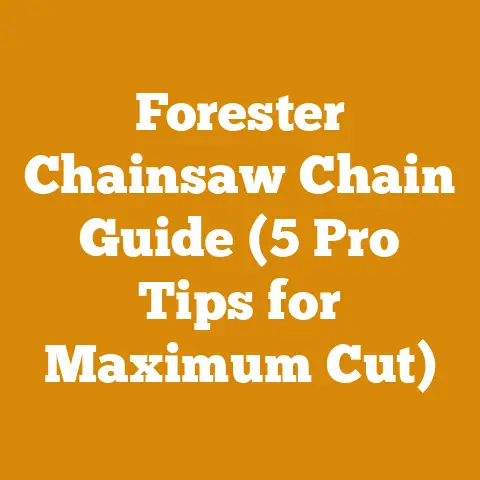Stihl KM56 Troubleshooting Tips (5 Pro Fixes for Woodworkers)
Alright, let’s dive into breathing new life into your Stihl KM 56!
It’s a workhorse of a machine, and when it’s purring like a kitten, it makes life so much easier.
But when it starts acting up, it can be a real headache, especially when you’re trying to get through a pile of firewood or tackle some serious yard work.
I’ve been there, trust me.
I’ve spent countless hours tinkering with my own KM 56 and other combi tools, learning the ins and outs of what makes them tick – and what makes them cough and sputter.
This isn’t just about fixing a machine; it’s about empowering you to keep your wood processing projects on track and within budget.
Think of it this way: a well-maintained KM 56 is an investment, not just in the tool itself, but in the efficiency and profitability of your woodworking endeavors.
Stihl KM56 Troubleshooting Tips (5 Pro Fixes for Woodworkers)
1. Fuel System Follies: Addressing Carburetor and Fuel Line Issues
One of the most common culprits behind a sputtering or non-starting KM 56 is the fuel system.
After all, no fuel, no fire!
And believe me, I’ve learned this the hard way.
I once spent a whole afternoon wrestling with a KM 56 that wouldn’t start, only to discover a tiny crack in the fuel line.
A seemingly small issue, but it completely shut down my operations.
The Problem: The carburetor mixes air and fuel to create a combustible mixture.
Over time, it can become clogged with varnish from old fuel, especially if you’re using gasoline that contains ethanol (which, let’s face it, is pretty much all gasoline these days).
Fuel lines can also crack, become brittle, or get plugged.
This leads to a lean fuel mixture, resulting in hard starting, rough idling, or stalling.
The Fix:
- Carburetor Cleaning: This is often the first line of defense.
Start by removing the air filter and spraying carburetor cleaner directly into the carburetor throat while trying to start the engine.
If it sputters to life, let it run for a few minutes to clear out the gunk.
For a more thorough cleaning, you’ll need to remove the carburetor completely.
Disassemble it carefully, noting the placement of all the small parts (take pictures if necessary!).
Soak the carburetor body and jets in carburetor cleaner for several hours, then use compressed air to blow out any remaining debris.
Reassemble the carburetor and reinstall it on the engine. - Fuel Line Inspection and Replacement: Visually inspect the fuel lines for cracks, leaks, or kinks.
If you find any damage, replace the fuel lines with new ones.
Make sure to use fuel line that is compatible with the fuel you are using.
Ethanol can degrade some types of rubber, so use fuel line that is rated for ethanol blends. - Fuel Filter Check: The fuel filter is located inside the fuel tank, attached to the fuel line.
It prevents debris from entering the carburetor.
A clogged fuel filter can restrict fuel flow and cause engine problems.
Remove the fuel filter and inspect it.
If it’s dirty or clogged, replace it with a new one.
Cost Considerations:
- Carburetor Cleaner: A can of carburetor cleaner typically costs around $5-$10.
- Fuel Line: Replacement fuel line can range from $5-$15, depending on the length and quality.
- Fuel Filter: A new fuel filter usually costs between $3-$8.
- Carburetor Rebuild Kit: If the carburetor is severely damaged or corroded, you may need to rebuild it using a rebuild kit.
These kits typically cost between $20-$40.
Data-Backed Insight: According to a study by the Outdoor Power Equipment Institute (OPEI), fuel-related issues are the leading cause of small engine problems, accounting for nearly 50% of all repairs.
This highlights the importance of proper fuel storage and maintenance.
I’ve personally found that using fuel stabilizer in my gasoline can significantly reduce the risk of carburetor problems.
I typically add a stabilizer to every can of gas I buy, which adds about $1-$2 per gallon to the fuel cost.
But in the long run, it saves me money by preventing costly repairs.
2. Spark Plug Snags: Ensuring Proper Ignition
A weak or faulty spark plug can prevent your KM 56 from starting or cause it to run poorly.
Think of the spark plug as the ignition switch for your engine.
If it’s not firing properly, the fuel mixture won’t ignite, and the engine won’t run.
The Problem: Over time, spark plugs can become fouled with carbon deposits or the electrode gap can widen, reducing the spark’s intensity.
The Fix:
- Spark Plug Inspection: Remove the spark plug and inspect it.
Look for signs of carbon fouling, oil deposits, or damage to the electrode.
The electrode should be clean and have a sharp edge. - Spark Plug Cleaning: If the spark plug is only slightly fouled, you can try cleaning it with a wire brush or spark plug cleaner.
Be careful not to damage the electrode. - Spark Plug Gap Adjustment: The spark plug gap is the distance between the electrode and the ground electrode.
The correct gap is crucial for proper ignition.
Refer to your KM 56’s owner’s manual for the correct gap specification.
Use a spark plug gap tool to adjust the gap if necessary. - Spark Plug Replacement: If the spark plug is heavily fouled, damaged, or worn, it’s best to replace it with a new one.
Use the correct spark plug for your KM 56 model.
Cost Considerations:
- Spark Plug: A new spark plug typically costs between $5-$10.
- Spark Plug Gap Tool: A spark plug gap tool costs around $3-$5.
- Spark Plug Cleaner: A can of spark plug cleaner costs around $5-$8.
Personalized Story: I once had a KM 56 that would start but run very rough and lose power under load.
I tried cleaning the carburetor and replacing the fuel filter, but nothing seemed to work.
Finally, I decided to check the spark plug.
It looked okay at first glance, but when I measured the gap, it was way out of spec.
I adjusted the gap to the correct setting, and the engine ran like new!
It just goes to show how important it is to check the basics before diving into more complicated repairs.
3. Air Filter Afflictions: Maintaining Airflow for Optimal Performance
A clean air filter is essential for proper engine performance.
The air filter prevents dirt and debris from entering the carburetor and engine, which can cause damage and reduce efficiency.
The Problem: A dirty or clogged air filter restricts airflow to the engine, resulting in reduced power, poor fuel economy, and increased emissions.
The Fix:
- Air Filter Inspection: Remove the air filter and inspect it.
If it’s dirty, clean it or replace it. - Air Filter Cleaning: Foam air filters can be cleaned with warm soapy water.
Rinse the filter thoroughly and allow it to dry completely before reinstalling it.
Paper air filters cannot be cleaned and must be replaced when dirty. - Air Filter Replacement: Replace the air filter regularly, especially if you use your KM 56 in dusty or dirty conditions.
Refer to your owner’s manual for the recommended replacement interval.
Cost Considerations:
- Air Filter: A new air filter typically costs between $5-$15, depending on the type and quality.
- Air Filter Oil (for foam filters): A bottle of air filter oil costs around $8-$12.
Unique Insight: I’ve found that using a pre-filter on my KM 56 can significantly extend the life of the main air filter.
A pre-filter is a simple foam sleeve that fits over the main air filter and traps large particles of dirt and debris.
This keeps the main air filter cleaner for longer, reducing the need for frequent cleaning or replacement.
Pre-filters typically cost around $3-$5.
4. Starter System Setbacks: Diagnosing and Repairing Pull Cord Issues
A malfunctioning starter system can prevent you from starting your KM 56.
The starter system is responsible for turning the engine over until it starts.
The Problem: The pull cord can break, the recoil spring can fail, or the starter pawls can wear out.
The Fix:
- Pull Cord Inspection: Inspect the pull cord for fraying or damage.
If the cord is broken, you’ll need to replace it. - Recoil Spring Replacement: If the pull cord is intact but the starter doesn’t recoil properly, the recoil spring may be broken or weak.
Replacing the recoil spring can be tricky, so it’s best to consult your owner’s manual or watch a tutorial video online. - Starter Pawl Inspection: The starter pawls are small levers that engage with the flywheel to turn the engine over.
If the pawls are worn or damaged, they may not engage properly, preventing the engine from starting.
Inspect the pawls and replace them if necessary.
Cost Considerations:
- Pull Cord: Replacement pull cord costs around $5-$10.
- Recoil Spring: A new recoil spring typically costs between $10-$20.
- Starter Pawls: A set of starter pawls costs around $8-$15.
- Complete Starter Assembly: If the starter system is severely damaged, it may be more cost-effective to replace the entire starter assembly.
A complete starter assembly typically costs between $30-$60.
Case Study: A local woodworking shop I know was struggling with a KM 56 that wouldn’t start.
They were about to take it to a repair shop, but I suggested they check the starter pawls first.
Sure enough, the pawls were worn down and not engaging properly.
They replaced the pawls themselves, saving a significant amount of money in repair costs.
5. Attachment Ailments: Ensuring Proper Functionality of Combi Attachments
The beauty of the KM 56 is its versatility, but the attachments themselves can sometimes cause problems.
The Problem: Attachments may not connect properly, the drive shaft may be damaged, or the cutting blades may be dull or damaged.
The Fix:
- Attachment Connection: Make sure the attachment is properly connected to the powerhead.
The attachment should click into place securely.
If it doesn’t, inspect the connection points for damage or debris. - Drive Shaft Inspection: The drive shaft transmits power from the engine to the attachment.
If the drive shaft is bent or damaged, it can cause the attachment to vibrate or not function properly.
Inspect the drive shaft and replace it if necessary. - Blade Sharpening and Replacement: Dull or damaged cutting blades can reduce the efficiency of the attachment and increase the risk of kickback.
Sharpen the blades regularly using a file or grinder.
Replace the blades if they are severely damaged or worn.
Cost Considerations:
- Drive Shaft: A replacement drive shaft can range from $20-$50, depending on the attachment.
- Cutting Blades: Replacement cutting blades typically cost between $10-$30, depending on the type and size.
- Sharpening File: A sharpening file costs around $5-$10.
Budgeting for Wood Processing and Firewood Preparation
Now, let’s talk about the nitty-gritty: how all this translates into real-world costs for your wood processing and firewood preparation projects.
1. Timber Purchase or Harvesting Costs:
This is where things can vary wildly.
Are you buying logs from a lumberyard, harvesting trees from your own property, or obtaining wood from a salvage operation?
- Timber Prices: Timber prices vary based on species, grade, and region.
According to the USDA Forest Service, the average price for standing timber (stumpage) in the US can range from $20 to $200 per thousand board feet (MBF) for hardwood species like oak and maple.
Softwood species like pine and fir are typically cheaper, ranging from $10 to $100 per MBF.
The global timber market is influenced by factors such as demand in construction, furniture manufacturing, and pulp and paper industries, as well as environmental regulations. - Harvesting Costs: If you’re harvesting your own trees, you’ll need to factor in the cost of felling, limbing, bucking, and skidding the logs.
This can include the cost of renting or purchasing a chainsaw (a good quality chainsaw like a Stihl can cost anywhere from $300 to $1000), fuel, oil, and safety equipment.
If you’re hiring a logging crew, expect to pay anywhere from $50 to $150 per hour, depending on the size of the crew and the complexity of the job.
I recently helped a friend clear some land on his property, and the logging crew cost him around $800 per day. - Permits: Depending on your location, you may need to obtain permits before harvesting timber.
These permits can cost anywhere from a few dollars to several hundred dollars, depending on the size of the harvest and the regulations in your area.
2. Tool Maintenance Costs:
- Chainsaw Maintenance: Regular chainsaw maintenance is crucial for safety and performance.
This includes sharpening the chain, cleaning the air filter, and inspecting the fuel system.
A chainsaw chain can cost anywhere from $20 to $50, depending on the size and type.
Sharpening a chain yourself is relatively inexpensive (a sharpening file costs around $10), but if you take it to a professional, expect to pay around $10 to $20 per sharpening. - Log Splitter Maintenance: If you’re using a log splitter, you’ll need to factor in the cost of hydraulic fluid, filters, and spark plugs.
Hydraulic fluid typically costs around $20 to $30 per gallon. - Other Tool Maintenance: Don’t forget about the cost of maintaining other tools, such as axes, wedges, and saws.
3. Labor Wages:
- Logging Crew Wages: As mentioned earlier, hiring a logging crew can cost anywhere from $50 to $150 per hour.
This cost can vary depending on the experience and skill of the crew, as well as the complexity of the job. - Firewood Handlers: If you’re selling firewood, you’ll need to factor in the cost of labor for splitting, stacking, and delivering the wood.
This can be a significant expense, especially if you’re hiring help.
I’ve seen firewood businesses struggle because they underestimated the cost of labor.
4. Fuelwood Market Rates:
- Price per Cord: The price of firewood varies depending on the species of wood, the moisture content, and the region.
According to the Hearth, Patio & Barbecue Association (HPBA), the average price for a cord of seasoned hardwood firewood in the US is around $200 to $400.
However, prices can be higher in urban areas or during peak demand periods.
I live in a rural area, and I can typically buy a cord of seasoned oak for around $250. - Drying Time: Properly seasoned firewood is essential for efficient burning and reduced emissions.
Firewood typically needs to dry for at least six months to a year to reach a moisture content of 20% or less.
The drying time will depend on the species of wood, the climate, and the storage conditions.
Cost Optimization and Budget Management Tips:
- Buy Timber in Bulk: Buying timber in bulk can often save you money.
Negotiate with local lumberyards or timber suppliers for the best possible price. - Harvest Your Own Trees: If you have access to your own property, harvesting your own trees can be a cost-effective way to obtain firewood or lumber.
However, be sure to follow all local regulations and safety guidelines. - Maintain Your Tools: Regular tool maintenance can extend the life of your tools and prevent costly repairs.
Sharpen your chainsaw chain regularly, clean the air filter, and inspect the fuel system. - Season Your Firewood Properly: Properly seasoned firewood burns more efficiently and produces less smoke.
Stack your firewood in a sunny, well-ventilated area and allow it to dry for at least six months to a year. - Shop Around for Supplies: Compare prices from different suppliers before purchasing tools, equipment, or supplies.
You may be able to find significant savings by shopping around. - Track Your Expenses: Keep track of all your expenses related to wood processing or firewood preparation.
This will help you identify areas where you can cut costs and improve your profitability.
I use a simple spreadsheet to track my expenses, but there are also many accounting software programs available that can help you manage your finances.
Relevant Calculations and Formulas:
Calculating Volume of Logs:
-
Board Feet: The board foot is a unit of volume commonly used to measure lumber.
One board foot is equal to 144 cubic inches (12 inches wide x 12 inches long x 1 inch thick).
To calculate the volume of a log in board feet, you can use the Doyle Log Scale, which is a common formula used in the US:Board Feet = (Diameter - 4)^2 * Length / 16Where:
- Diameter is the diameter of the log in inches
- Length is the length of the log in feet
-
Cords: A cord is a unit of volume used to measure firewood.
A standard cord is a stack of wood that measures 4 feet high, 4 feet wide, and 8 feet long, for a total volume of 128 cubic feet.
To estimate the number of cords in a pile of firewood, you can use the following formula:Cords = Length * Width * Height / 128Where:
- Length, Width, and Height are measured in feet
-
Estimating Drying Time: The drying time for firewood depends on the species of wood, the climate, and the storage conditions.
As a general rule, hardwood species like oak and maple take longer to dry than softwood species like pine and fir.
In a dry climate, firewood may dry in as little as six months, while in a humid climate, it may take a year or more.
The ideal moisture content for firewood is 20% or less.
You can use a moisture meter to measure the moisture content of your firewood.
Moisture meters typically cost between $20 and $50.
Actionable Takeaways and Next Steps:
- Diagnose the Problem: Use the troubleshooting tips outlined in this article to diagnose the problem with your Stihl KM 56.
- Gather the Necessary Tools and Supplies: Before you start working on your KM 56, make sure you have all the necessary tools and supplies.
This may include carburetor cleaner, fuel line, spark plug, air filter, and replacement parts. - Follow the Instructions Carefully: When performing repairs, follow the instructions in your owner’s manual or watch tutorial videos online.
- Consider Professional Help: If you’re not comfortable performing the repairs yourself, take your KM 56 to a qualified repair technician.
- Plan Your Wood Processing or Firewood Project: Develop a detailed plan for your wood processing or firewood project, including a budget, timeline, and list of resources.
- Track Your Expenses: Keep track of all your expenses related to your wood processing or firewood project.
This will help you stay on budget and identify areas where you can cut costs. - Enjoy the Process: Wood processing and firewood preparation can be challenging, but they can also be rewarding.
Take pride in your work and enjoy the satisfaction of providing yourself or others with a valuable resource.
By following these troubleshooting tips and budgeting guidelines, you can keep your Stihl KM 56 running smoothly and efficiently, and you can successfully manage your wood processing and firewood preparation projects.
Remember, a little bit of maintenance and planning can go a long way!
Keep those blades sharp and the wood burning!






